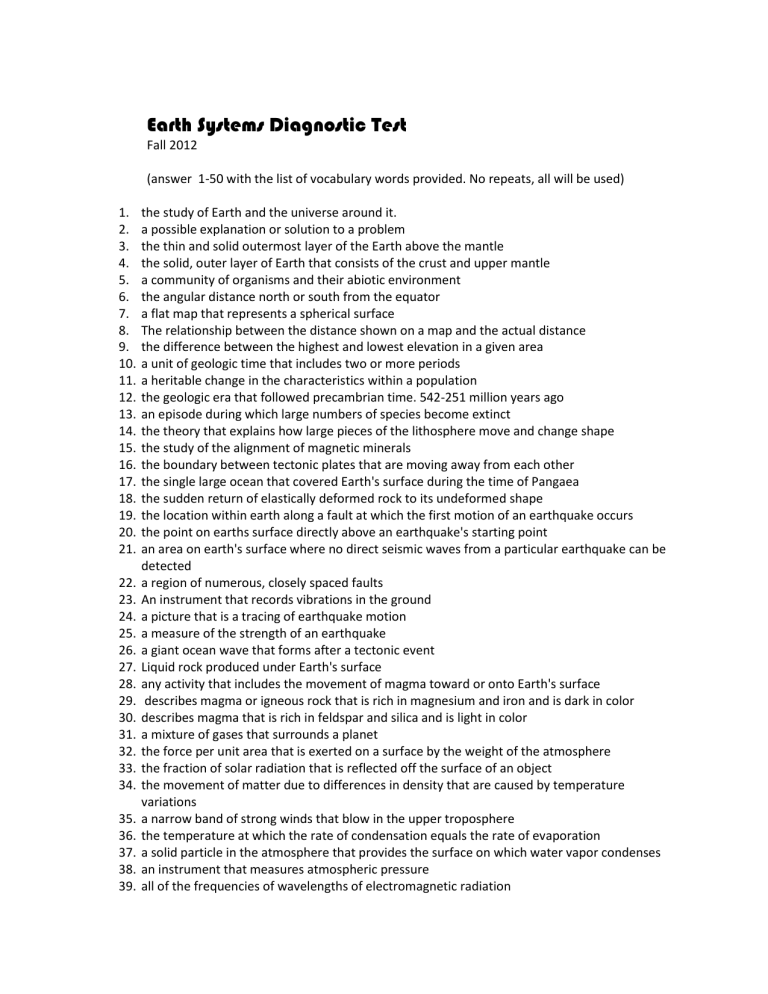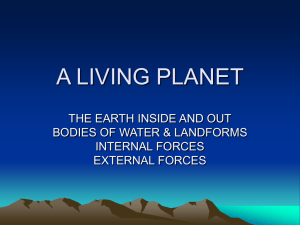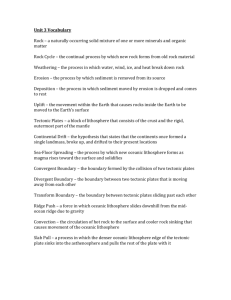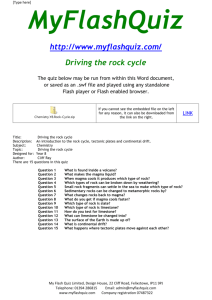Earth Systems diagnostic

Earth Systems Diagnostic Test
Fall 2012
(answer 1-50 with the list of vocabulary words provided. No repeats, all will be used)
1.
the study of Earth and the universe around it.
2.
a possible explanation or solution to a problem
3.
the thin and solid outermost layer of the Earth above the mantle
4.
the solid, outer layer of Earth that consists of the crust and upper mantle
5.
a community of organisms and their abiotic environment
6.
the angular distance north or south from the equator
7.
a flat map that represents a spherical surface
8.
The relationship between the distance shown on a map and the actual distance
9.
the difference between the highest and lowest elevation in a given area
10.
a unit of geologic time that includes two or more periods
11.
a heritable change in the characteristics within a population
12.
the geologic era that followed precambrian time. 542-251 million years ago
13.
an episode during which large numbers of species become extinct
14.
the theory that explains how large pieces of the lithosphere move and change shape
15.
the study of the alignment of magnetic minerals
16.
the boundary between tectonic plates that are moving away from each other
17.
the single large ocean that covered Earth's surface during the time of Pangaea
18.
the sudden return of elastically deformed rock to its undeformed shape
19.
the location within earth along a fault at which the first motion of an earthquake occurs
20.
the point on earths surface directly above an earthquake's starting point
21.
an area on earth's surface where no direct seismic waves from a particular earthquake can be detected
22.
a region of numerous, closely spaced faults
23.
An instrument that records vibrations in the ground
24.
a picture that is a tracing of earthquake motion
25.
a measure of the strength of an earthquake
26.
a giant ocean wave that forms after a tectonic event
27.
Liquid rock produced under Earth's surface
28.
any activity that includes the movement of magma toward or onto Earth's surface
29.
describes magma or igneous rock that is rich in magnesium and iron and is dark in color
30.
describes magma that is rich in feldspar and silica and is light in color
31.
a mixture of gases that surrounds a planet
32.
the force per unit area that is exerted on a surface by the weight of the atmosphere
33.
the fraction of solar radiation that is reflected off the surface of an object
34.
the movement of matter due to differences in density that are caused by temperature variations
35.
a narrow band of strong winds that blow in the upper troposphere
36.
the temperature at which the rate of condensation equals the rate of evaporation
37.
a solid particle in the atmosphere that provides the surface on which water vapor condenses
38.
an instrument that measures atmospheric pressure
39.
all of the frequencies of wavelengths of electromagnetic radiation
40.
a small body from which a planet originated in the early stages of development of the solar system.
41.
a piece of lithosphere that has a unique geologic history that differs from the histories of surrounding lithosphere
42.
the natural process by which atmospheric and environmental agents such as wind, rain, and temperature changes, disintegrates, and decomposes rocks
43.
A loose mixture of rock fragments and organic material that can support the growth of vegetation
44.
the area of land that is drained by a river system.
45.
a fan shaped mass of rock material deposited at the mouth of a stream
46.
an area of the shoreline that is made up of deposited sediment
47.
a small body of water separated from the sea by a low, narrow strip of land
48.
a measure of the amount of dissolved salts in a given amount of liquid
49.
a horizontal movement of water in a well-defined pattern
50.
the curving of the path of a moving object from an otherwise straight path due to the Earth’s rotation
(Answer 51-63 in complete sentences on your own paper)
51.
List the steps of the scientific method, giving a short description of each.
52.
List the major components (compounds) of Earth’s atmosphere.
53.
Starting with the surface of earth, list and describe both the structural and compositional layers of Earth’s interior.
54.
What is the mass of Earth?
55.
Discuss 4 major cloud types. Give Apx height, and associated weather.
56.
Starting with full, list all moon phases.
57.
What is plate tectonics? What causes the movement of the plates? Discuss the 3 major interactions that occur at plate boundaries.
58.
Give major characteristics of Hurricanes? Discuss their formation
59.
Why is the sky blue?
60.
What is the difference between a rock and a mineral?
61.
What is earth’s highest point? Deepest point?
62.
How old is Earth?
63.
How did the Earth form?
(Use the following words for 1-50. No repeats and all will be used)
Electromagnetic spectrum- Convection- Jet stream- Dew point- Scale- Relief- Era -
Soil- Watershed- Delta- - Evolution- - Seismogram- Magnitude- Paleozoic era-
Epicenter- Shadow zone- Divergent boundary- Panthalassa- Elastic rebound- -
Lithosphere - Lagoon- -Seismograph – Tsunami- Mass Extinction- Plate tectonics-
Beach- Salinity- Currents- Coriolis effect- Paleomagnetism- Planetesimal- Terrane-
Fault zone Weathering- Focus- Magma- Volcanism- Mafic- Felsic-
Atmospheric pressure- Hypothesis-Crust- Albedo- Condensation nuclei-Barometer-
Earth Systems- Ecosystem- Latitude- Map Projection- Atmosphere-
Use the following words for 1-50. No repeats and all will be used)
Electromagnetic spectrum- Convection- Jet stream- Dew point- Scale- Relief- Era -
Soil- Watershed- Delta- - Evolution- - Seismogram- Magnitude- Paleozoic era-
Epicenter- Shadow zone- Divergent boundary- Panthalassa- Elastic rebound- -
Lithosphere - Lagoon- -Seismograph – Tsunami- Mass Extinction- Plate tectonics-
Beach- Salinity- Currents- Coriolis effect- Paleomagnetism- Planetesimal- Terrane-
Fault zone Weathering- Focus- Magma- Volcanism- Mafic- Felsic-
Atmospheric pressure- Hypothesis-Crust- Albedo- Condensation nuclei-Barometer-
Earth Systems- Ecosystem- Latitude- Map Projection- Atmosphere-
Earth Systems Diagnostic Test
Fall 2012
(answer 1-50 with the list of vocabulary words provided. No repeats, all will be used)
1.
Earth Systems- the study of Earth and the universe around it.
2.
Hypothesis- a possible explanation or solution to a problem
3.
Crust- the thin and solid outermost layer of the Earth above the mantle
4.
Lithosphere- the solid, outer layer of Earth that consists of the crust and upper mantle
5.
Ecosystem- a community of organisms and their abiotic environment
6.
Latitude- the angular distance north or south from the equator
7.
Map Projection- a flat map that represents a spherical surface
8.
Scale- The relationship between the distance shown on a map and the actual distance
9.
Relief- the difference between the highest and lowest elevation in a given area
10.
Era- a unit of geologic time that includes two or more periods
11.
Evolution- a heritable change in the characteristics within a population
12.
Paleozoic era- the geologic era that followed precambrian time. 542-251 million years ago
13.
Mass Extinction- an episode during which large numbers of species become extinct
14.
Plate tectonics- the theory that explains how large pieces of the lithosphere move and change shape
15.
Paleomagnetism- the study of the alignment of magnetic minerals
16.
Divergent boundary- the boundary between tectonic plates that are moving away from each other
17.
Panthalassa- the single large ocean that covered Earth's surface during the time of Pangaea
18.
Elastic rebound- the sudden return of elastically deformed rock to its undeformed shape
19.
Focus- the location within earth along a fault at which the first motion of an earthquake occurs
20.
Epicenter- the point on earths surface directly above an earthquake's starting point
21.
Shadow zone- an area on earth's surface where no direct seismic waves from a particular earthquake can be detected
22.
Fault zone- a region of numerous, closely spaced faults
23.
Seismograph- An instrument that records vibrations in the ground
24.
Seismogram- a picture that is a tracing of earthquake motion
25.
Magnitude- a measure of the strength of an earthquake
26.
Tsunami- a giant ocean wave that forms after a tectonic event
27.
Magma- Liquid rock produced under Earth's surface
28.
Volcanism- any activity that includes the movement of magma toward or onto Earth's surface
29.
Mafic- describes magma or igneous rock that is rich in magnesium and iron and is dark in color
30.
Felsic- describes magma that is rich in feldspar and silica and is light in color
31.
Atmosphere- a mixture of gases that surrounds a planet
32.
Atmospheric pressure- the force per unit area that is exerted on a surface by the weight of the atmosphere
33.
Albedo- the fraction of solar radiation that is reflected off the surface of an object
34.
Convection- the movement of matter due to differences in density that are caused by temperature variations
35.
Jet stream- a narrow band of strong winds that blow in the upper troposphere
36.
Dew point- the temperature at which the rate of condensation equals the rate of evaporation
37.
Condensation nuclei-a solid particle in the atmosphere that provides the surface on which water vapor condenses
38.
Barometer- an instrument that measures atmospheric pressure
39.
Electromagnetic spectrum- all of the frequencies of wavelengths of electromagnetic radiation
40.
Planetesimal- a small body from which a planet originated in the early stages of development of the solar system.
41.
Terrane- a piece of lithosphere that has a uniquegeologic history that differs from the histories of surrounding lithosphere
42.
Weathering- the natural process by which atmospheric and environmental agents such as wind, rain, and temperature changes, disintegrates, and decomposes rocks
43.
Soil- A loose mixture of rock fragments and organic material that can support the growth of vegetation
44.
Watershed- the area of land that is drained by a river system.
45.
Delta- a fan shaped mass of rock material deposited at the mouth of a stream
46.
Beach- an area of the shoreline that is made up of deposited sediment
47.
Lagoon- a small body of water separated from the sea by a low, narrow strip of land
48.
Salinity- a measure of the amount of dissolved salts in a given amount of liquid
49.
Currents- a horizontal movement of water in a well-defined pattern
50.
Coriolis effect- the curving of the path of a moving object from an otherwise straight path due to the Earth’s rotation








